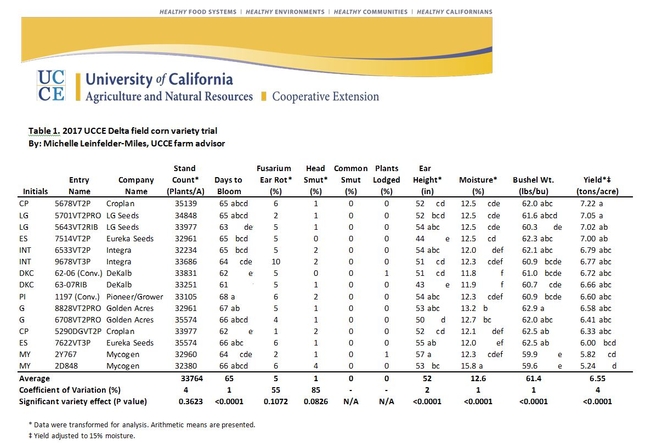The results of the 2017 UCCE Delta field corn variety trial, located on Tyler Island, are shown in Table 1 (below). Three replicate blocks of fifteen varieties were planted on May 9th by air planter. The trial was planted almost two weeks later than the 2016 trial, due to the wet winter and spring. The fifteen varieties included 14 varieties submitted by seed companies and one submitted by the grower. Glyphosate-tolerant and conventional varieties were tested; conventional varieties are indicated in Table 1 as (Conv.). Each plot consisted of four 30-inch beds on an average row length of 1218 feet. Seed was planted approximately two inches deep and six inches apart down the row. The soil is a Rindge mucky silt loam with approximately 20 percent organic matter in the top 15 inches of soil. The Rindge series is a mucky peat soil down to about 60 inches, and approximately 55,600 acres in the Delta are described by the Rindge classification. The previous crop in the field was corn. Subsurface irrigation by “spud ditch” was employed three times. Nitrogen was applied pre-plant (125 units/acre as NH3), and 34 gallons/acre of 8-24-6 with ½% of zinc (additional 31 units/acre of N) was knifed in at planting. Weed control was by cultivation and herbicide program (Laudis, Crosshair, Super Spread MSO, UAN 32%). Onager miticide was applied. The field was harvested on October 18th.
Stand counts were made approximately two weeks after planting, and bloom was assessed over the week of July 10th. While bloom occurred later this year due to the later planting, the number of days to bloom was less than in 2016. Across all varieties, the average number of days to bloom was 65, compared to 70 in 2016. This is likely due to warmer temperatures in 2017 compared to 2016. The average high temperature between planting and bloom was 86°F, and the average low temperature was 52°F. There were three days above 100°F during the time from planting to bloom, and a total of 11 days over 100°F for the season. Whereas, between planting and bloom in 2016, the average high temperature was 84°F, the average low temperature was 50°F, and there was one day above 100°F, (six total for the season). (Temperature data is from the neighboring Staten Island CIMIS station.)
We monitored disease incidence and plant lodging in late September. At that time, very little lodging was observed, as indicated by the data. Heavy winds occurred in early October, however, between rating lodging and harvesting the crop. At harvest, we observed more lodging but did not collect additional data. Based on observations, varieties MY 2D848, ES 7622VT3P, and DKC 63-07RIB experienced more lodging than other varieties from the early-October winds.
The table presents mean values for the three replicates. The statistical method used to compare the means is called Tukey's range test. Varieties were considered statistically different if their P value was less than 0.05, or 5 percent. What this means is that when differences between varieties exist, we are 95% certain that the two varieties are actually different; the results are not due to random chance. Differences between varieties are indicated by different letters following the mean. For example, a variety that has only the letter “a” after the mean yield value is different from a variety that is followed by only the letter “b”, but it is not different from a variety whose mean value is followed by both letters (“ab”). Similarly, a variety whose mean yield is followed by the letters “ab” is not different from a variety whose mean yield is followed by the letters “bc”. Twelve varieties have a letter “a” following their mean yield, which means that those twelve varieties all performed similarly in the trial. In other words, based on this research, we cannot attribute numerical differences to variety differences. Among varieties, there were also statistical differences in bloom date, ear height, grain moisture, and bushelweight. The CV, or coefficient of variation, is the standard deviation divided by the mean, or a measure of variability in relation to the mean. For the diseases, the variability among the three replicates was very high.
Special thanks go to the cooperating growers and seed companies. This report is available from my website.
